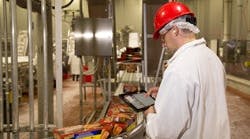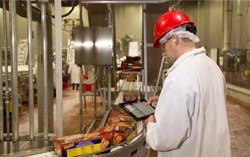Is information software in your toolbox?
People, processes, and technologies are connecting and collaborating like never before. Converging information technologies (IT) and operational technologies (OT) are driving this transformation – creating The Connected Enterprise – and having a huge impact on global productivity and competitiveness. Because The Connected Enterprise leverages enhancing technologies, like the Internet of Things, there are virtually no limits in the ways in which collaboration can take place. It can and will continually evolve and improve to meet the needs of the user.
The challenge for manufacturers and industrial operators is providing connections and collaboration that are near frictionless for machine- and user-focused capabilities across operations without making major investments in new equipment. Capital expenditures are limited across many industrial industries, requiring many companies to focus their efforts on connecting and optimizing the assorted mix of equipment that’s already in place, new and old.
Think about digital photography. Moving digital did not change what makes a good photograph, but the ability to easily tag an image to a location or another member of a social network has changed how we use and value photography in incredible ways. It’s created new products, businesses and trends, from Facebook, Instagram, and the “selfie” to user-generated food images driving customers to (or away from) restaurants the world over.
For manufacturing, integrated control and information software can be a similar game changer, enabling collaboration capabilities to be relatively easily infused into legacy assets. For example, new mobile capabilities are being introduced across platforms such as FactoryTalk VantagePoint v6.1 software from Rockwell Automation, an enterprise manufacturing intelligence (EMI) software offering that provides unseen “frictionless” levels of customization and user enablement to track performance metrics and deliver data analytics.
Users can now customize content across desktop and mobile devices to track data in ways that are unique to specific viewing preferences, roles, and business priorities, and then instantly and easily share it with collaborators. For example, plant managers can view production rates across each line on a single screen, so they can quickly react if production targets are at risk. A reliability manager might use the software to keep a close eye on performance metrics of specific equipment types – such as variable frequency drives – across a site or multiple sites, so they can ensure uptime of crucial assets and assist in predictive maintenance activities.
This new software trend departs from the traditional define-and-dictate model, in which the system is preprogrammed with specific definitions that then dictate what users can and cannot do, in favor of a more open, lean and modular system. This flexibility empowers all levels of employees, giving them the freedom to develop the performance-tracking definitions that are most relevant to their specific operations and then to change them as needed, all without having to burden IT and OT with additional development. For example, maintenance personnel might be focused like a laser on uptime and have their dashboards show them line or machine uptime metrics, whereas a plant manager might define their view by production rates or asset utilization.
Energy management is another area where information software is allowing manufacturers and industrial operators to utilize the benefits of The Connected Enterprise and get more out of their legacy equipment. Energy intelligence software that integrates with a plant’s existing drives can monitor energy usage and help operators better understand and compare energy costs. It allows them to track equipment lifecycles and identify where investments, such as maintenance or replacements, may be necessary.
This software infusion is transforming how end users access and utilize information, but it’s also changing how developers create and upgrade their offerings. Equipment and software cannot be developed as independent or isolated products, nor on timelines that don’t allow for quick iteration and upgrades. Everything can now be connected within The Connected Enterprise, meaning that products must be developed to live as part of a larger ecosystem with a focus on delivering value to user personas. They must be considered within the context of other products and multiple roles in a plant.
And, they have to keep up with the end user's always-evolving needs, constantly updating and introducing new features based on user data and preferences. For example, users showed a preference for device-agnostic mobile capabilities, so software applications have been shifted to dynamically display the application and best fit the mobile device being used. Through constant software updates, manufacturers should be able to expect that their control and information software investments will continue to deliver incremental value with each new release that is backed by user data. These changes are leading to a greater emphasis on system-level thinking, cross-team collaboration, and lean start-up principles during the software development process.
The Connected Enterprise can help manufacturers drive exponential value out of their existing equipment and new investments. Five years into its own Connected Enterprise journey, improved collaboration and processes have allowed Rockwell Automation to lower inventory and realize 30 percent savings annually in capital avoidance, reduce supply chain lead times by 50 percent, reduce parts per million defects by 50 percent and improve annual productivity by 4 to 5 percent. The information is there, in existing and new manufacturing infrastructures. Now it’s about connecting the right data points, people and processes to unleash exponential value from these systems.


